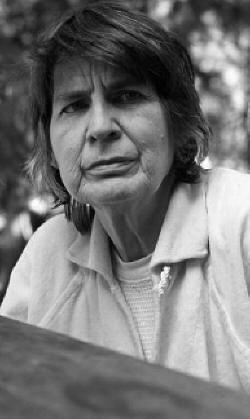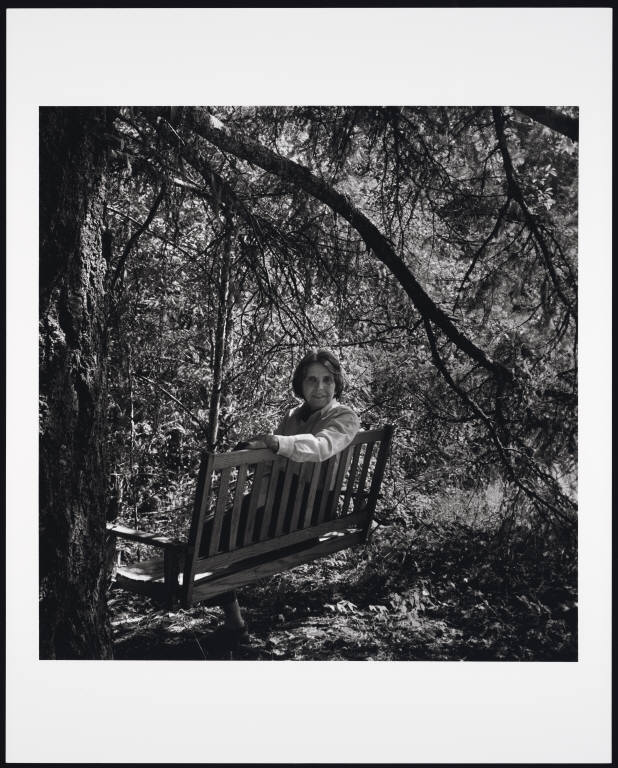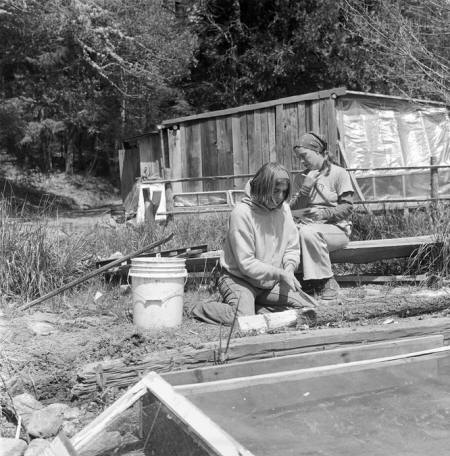

Partner Jean Mountaingrove
Queer Places:
Rootworks, 2000 King Mt Trail, Wolf Creek, OR
97497
Oregon Women's Land Trust (OWL) Farm, Days Creek Rd, Days Creek, OR 97429
 Ruth Mountaingrove (February 21, 1923 – December 18, 2016) was an American lesbian-feminist photographer, poet and musician, known for her photography documenting the lesbian land movement in Southern Oregon.[1][2]
Ruth Mountaingrove (February 21, 1923 – December 18, 2016) was an American lesbian-feminist photographer, poet and musician, known for her photography documenting the lesbian land movement in Southern Oregon.[1][2]
She was born Ruth Shook[3] on February 21, 1923 in Philadelphia, Pennsylvania to Edith Shelling and Herbert Daniel Shook.[1] She earned a Bachelor of Science in Education degree from Kutztown State Teacher's College in 1945, majoring in science with minors in English and Spanish. In 1946, she published a book of poems, Rhythms of Spring, and married Bern Ikeler.[1][4] After nineteen years of marriage and five children, they divorced in 1965. Mountaingrove joined the Philadelphia chapter of NOW in 1966, and worked to change abortion laws.[2] She helped found Women in Transition by writing for the newspaper, assisting battered women, and helped facilitate the first lesbian group in the city.[2]
She met her future partner Jean Mountaingrove in 1970. When she met Jean, realized that she is a lesbian, and started to make a living with writing for a magazine, Country Women, and newspaper, the Women’s Press, in Eugene, Oregon. Because of being lesbians, she and Jean were expelled from their Mountain Grove home.[2] Country Women supported their search for a place to settle around the West Coast.[2] In 1971 they moved to Southern Oregon, taking the name of the intentional community where they lived for two years, Mountain Grove. They moved to Golden, Oregon, which was a gay commune and founded WomanSpirit,[1][2][5] a lesbian feminist quarterly published collectively near Wolf Creek, Oregon from 1974–1984. The magazine was established, inspired by the experience of writing for Country Women. It was the first American lesbian/feminist periodical to be dedicated to both feminism and spirituality.[6][7] Their vision for the magazine was "international and radical feminist. We wanted a cultural revolution—a total reordering of institutions and values. It was to be a modest magazine with grand goals."[8] One of the goals is "to validate that it's okay to be wherever you are in your own development". Ruth and Jean wanted all women to feel having many other people who shares the same spirit and experiences.[9] The contents of this magazine are pliable as they are what readers supplied and dealt with by anyone who could help at that time, so that the magazine's spirituality is not firm.[9]

Jean Moutaingrove, Featured in
Particular Voices: Portraits of Gay
and Lesbian Writers by Robert Giard [Rights Notice: Copyright Jonathan G. Silin (jsilin@optonline.net)]

Jean Mountaingrove and another women stripping a log of bark
(Jean Mountaingrove wearing a headband using a hatchet to remove bark from a log. Another woman, wearing a bandana is sitting next to Jean Mountaingrove.
)
In the spirit of removing "man" and "men" from her descriptions of her work, Mountaingrove and Tee Corinne led "ovular" photography workshops instead of "seminars" on photography,[10] where "women could learn photography in the context of the women's movement, providing a means for the women to examine the differences between the way men pictured women and the way the women saw themselves."[8][11] The Blatant Image (a feminist photography magazine) grew out of the ovular workshops.[11] Ruth took the pictures included in the materials Phillis Lyon and Del Martin collected for their magazine called Lesbian Love and Liberation (1973).[12]
WomanSpirit was not destined to stay long at Golden, because soon after its founding the Mountaingroves went on to found, or re-found, Rootworks, another lesbian community, on a seven-acre tract of land near Sunny Valley, Oregon. The Mountaingroves purchased the land in 1978 and it's here that Ruth Mountaingrove published the book Turned on Woman's Songbook and a book of poetry, For Those Who Cannot Sleep.[2] Between 1974 and 1986, Mountaingrove spent a 12-year period photographing women in the lesbian community in Oregon and other parts of the United States.[5] She photographed meetings of the Oregon Women's Land Trust, documenting their lives at OWL Farm, a southern Oregon lesbian land community providing "access to rural land in order to be able to live outside of mainstream patriarchal culture".[13] The Mountaingroves separated in 1985.[1]
After her 1986 move to Arcata, California, Mountaingrove's art shifted from documentary photography to more experimental darkroom and digital images through a process she called "drawing with light", exploring photography as an abstract artistic medium, "like sumi ink drawings, or in some cases like paintings".[1][5] Her photography was exhibited in California, Massachusetts, Oregon, Pennsylvania, Texas, and Washington, and she held solo exhibits at three venues: Northcoast Internet, SHNEngineering, and The Lesbian, Gay, Bi-sexual, Transgendered Center.[5]
Mountaingrove died on December 18, 2016 at age 93 at Ida Emmerson Hospice House in Eureka.[3]
My published books: